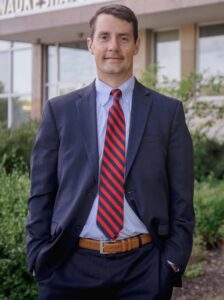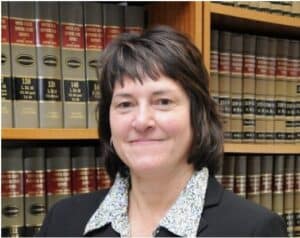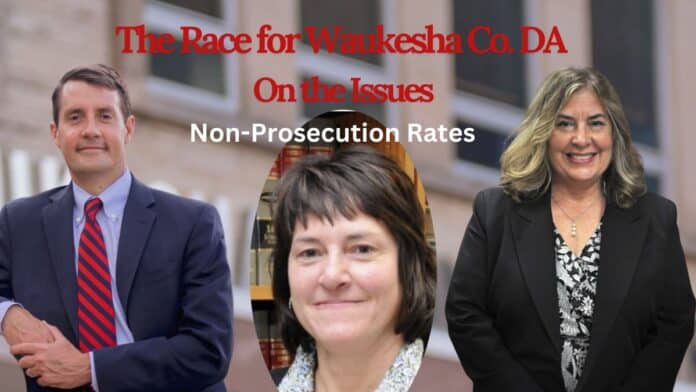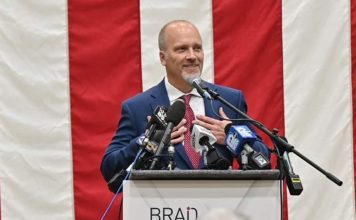The numbers also show that Waukesha County DA Sue Opper’s office overall has an extremely low non-prosecution percentage compared to Milwaukee County DA John Chisholm. Her office charges about 92 percent of cases, on average.
Waukesha County DA candidate Mike Thurston has a much higher non-prosecution percentage than his opponent in the race, Lesli Boese, and that’s held true over time. Since 2022, Thurston’s non-prosecution percentage averaged 21 percent. Boese’s non-prosecution percentage averaged only 1.6 percent, according to records obtained by Wisconsin Right Now through an open records request.
What is a non-prosecution percentage? Police refer charges to the DA’s office, and a prosecutor is assigned to review the case. The non-prosecution percentage is the percentage of those cases that a prosecutor rejects, not choosing to file criminal charges.
However, our open records request shows, Thurston handles twice as many cases and has fewer cases still under review. Furthermore, Thurston and Boese handle different units, as he is assigned to sensitive crimes (like sexual assault and domestic violence), and she handles drug cases.
The data comes from documents sent to Wisconsin Right Now by Waukesha County District Attorney Sue Opper’s office after an open records request. Both Thurston and Boese are deputy DAs in the office who are running as Republicans in the Aug. 13 primary. [Editor’s note: We have also requested the numbers from the Kenosha County deputy DA who is running in that race as a point of comparison.]
Opper is retiring; however, the numbers are great for her legacy. They show that Opper has been a hardline DA when it comes to charging percentage, and her statistics also document how aberrantly high Milwaukee County DA John Chisholm’s non-prosecution rate has been in comparison.
Thurston’s campaign has tried to shift the discussion to the fact that Boese has more cases still under review than Thurston, which he is calling a “backlog.” The documents show that his under-review numbers for her are accurate. The Thurston campaign did not respond to a request for comment from WRN about the non-prosecution percentages and did not contest them; however, his campaign manager claimed on social media that comparing the two prosecutors is “comparing apples to oranges,” presumably because of their different assignments. And he whipped out a press release focusing on the under-review statistics.
In fact, he argued that the higher non-prosecution percentage proves he’s an “efficient and decisive” prosecutor.
“As a sensitive crimes prosecutor, I don’t have the luxury of reviewing cases with audio and video recording footage,” Thurston said in the press release. “Often, my referrals concern a single outcry of a child or a woman who has been abused. The issue then becomes whether corroborating evidence exists. We are all duty-bound to charge only those cases that we can prove beyond a reasonable doubt. The numbers provided as a result of the open records request illustrate my efficient and decisive review of these referrals.”

Boese, who co-prosecuted the Waukesha Christmas parade massacre trial, responded to our request for comment. “Waukesha needs a district attorney who not only pledges to be tough on crime but actually follows through on that pledge by charging criminals and holding them responsible for their actions,” she said. “We owe it to the victims of these crimes to demand justice.”
If you count all years going back to 2015, both Thurston’s and Boese’s non-prosecution percentages rise slightly – his to 24 percent overall and hers to 3 percent. That means that his non-prosecution percentage historically is 8 times higher than hers.
Wisconsin Right Now has taken the lead in scrutinizing the candidates and their records. You can see more of our reporting here.
The records provided by Opper show:
- In 2022, Thurston decided not to prosecute 26 percent of his referred cases, the documents show. In 2023, his non-prosecution percentage was 22 percent. In 2024, while running for election, Thurston’s non-prosecution percentage dropped to 16 percent. Those numbers are well over the office as a whole.
- Boese’s non-prosecution numbers for 2022 is 1 percent. In 2023, Boese decided not to prosecute 2 percent of her cases, according to the documents Opper provided. Boese’s was 1.9 percent. That’s well under the office as a whole.
Read the documents in full here: REDACTED SLO REPORT
Boese’s campaign filed its own open records request for non-prosecution figures and gave them to WRN. That’s separate from the open records request that we had already filed.
The Boese campaign asked for records going back to 2015 “that detail the ‘no prosecution,’ ‘more investigation needed’ and ‘charged’ rates on any and all cases during this time period for attorneys Michael Thurston and Lesli Boese.”

The differences stayed fairly consistent with WRN’s findings from the more recent years.
Opper’s letter to Boese’s campaign says:
DDA Mike Thurston 1/1/2015-6/8/2024 (Note: Thurston did not start working in the Waukesha DA’s office until 12/28/2015.)
-1,866 cases assigned to him
-1 case currently under review
-455 declined prosecution (that’s 24 percent)
DDA Lesli Boese 1/1/2015-6/8/2024
-1,658 cases assigned
-103 cases are currently under review (editor’s note: 44 of those are from 2022 through the present, meaning the rest are even older than that).
-50 declined prosecution (that’s 3.2 percent)
Note: We subtracted the cases of review from the referred total and then figured out the percentage of those cases that were not prosecuted.
“As District Attorney, one of my top priorities is to continue to work alongside and support our law enforcement community,” said Boese, who is the daughter of a former police officer. “I work closely with law enforcement to ensure thorough investigations are performed in the cases they refer to me. As a result of their investigations and my commitment to holding criminals accountable, the number of referrals I decline to prosecute is very low.”
Cases under review & caseload
Thurston handled almost twice as many cases as Boese; however, Boese had 17.4 percent of her 2024 cases still under review compared to 2.6 percent for Thurston, WRN’s open records request found.
We would also note that she was co-chair on the extremely time-consuming Waukesha Christmas parade prosecution, which lasted a year. Darrell Brooks was sentenced in November 2022, a year after that massacre.
Boese also has more cases still under review for 2022 and 2023. For those years, Thurston has zero cases still under review. Meanwhile, 14.5 percent of Boese’s cases remained under review in 2022 and about the same in 2023 the documents show.
We gave both campaigns ample time to respond to the numbers.
“From 2018 to the present, my opponent has 103 major felony drug dealing cases ‘under review,’ meaning she hasn’t made a charging decision one way or another on these referrals,” Thurston claimed in his press release. “These referrals include serious offenses such as Possession with Intent to Deliver Cocaine, Reckless Homicide, Maintaining a Drug House, and Manufacture and Delivery of Heroin. At least ten of these offenders, where no charging decision has been made, have gone on to commit additional offenses.”
You can read his statement in full at the end of this article. Wisconsin Right Now asked Thurston’s campaign for a list of the 10 offenders; however, they have refused to produce the names. It’s unclear how the campaign could determine such a list since the cases are under review and wouldn’t be on CCAP for public scrutiny.
In the lone debate so far, Boese responded that drug cases are very complex and take a lot of investigative time because confidential informants must be developed. Sometimes such cases are sent back for further investigation.
Thurston’s website says he served as the regional domestic violence resource prosecutor in 2015 when hired in Wauksha and transitioned into Waukesha County’s primary sensitive crimes prosecutor in 2017.
DA Sue Opper’s extremely low non-prosecution rate
One thing is crystal clear from the numbers: Retiring DA Sue Opper has been a very hardline DA when it comes to prosecuting cases, as almost all cases referred to her office by police agencies get charged. That’s not true of her neighboring DA in Milwaukee County, John Chisholm.

However, her non-prosecution numbers help put Chisholm’s into context by showing how aberrant they are.
Thurston’s five donations to Democrat Chisholm over the years have caused controversy in the race. Thurston, who used to work in the Milwaukee County DA’s office, said in the only DA debate that he has since grown disappointed in Chisholm, but Boese questioned why it took him so long.
In 2024, to date, the Waukesha County DA’s office office has had 3,785 referrals overall, with 716 still under review. That leaves 3,069 cases where a prosecution decision was made. The decision was made not to prosecute 180 of them. That’s a non-prosecution rate of 5.8 percent.
In 2023, the Waukesha County DA’s office received 7,894 referrals. Of those, 467 cases remain under review. That leaves 7,427 cases that were either prosecuted or not prosecuted. Of those, 636 were not prosecuted. That’s just 8.5 percent.
In 2022, there were 7,725 cases referred to the Waukesha County DA’s office in all. There are 360 cases still under review from that year. That leaves 7,365 cases that were either prosecuted or not prosecuted. Of those, there were 718 cases with a status of “no prosecution.” That’s a non-prosecution rate of 9.7 percent.
It’s worth noting that Chisholm’s office was referred more than 25,000 cases in 2022, the latest year available.
In 2022, the latest year available, Chisholm’s office has charged only 42% of referrals, according to the DA’s dashboard.
The dashboard does not distinguish how many of those are still under review vs. how many were not prosecuted, though.
Meanwhile, Opper’s office’s non-prosecution rate is dropping even more in 2024. So is Thurston’s in 2024, an election year.
Differences in units explored
To be sure, some of the differences in the non-prosecution numbers between Boese and Thurston can be explained by the different units they run. Thurston made this point in the only DA debate, sponsored by the GOP. He was responding to Boese arguing that he had amended more cases than she has, a different metric from a decision not to prosecute a case in the first place.
According to Boese, Thurston reduced 32% of his cases in a recent time frame from felonies to misdemeanors and dismissed 20% of them, numbers much higher than hers. In contrast, Boese said, “2% of my caseload was amended from felonies to misdemeanors. 11% was dismissed.”
Thurston threw out his own metrics in the debate; he claims he has handled far more jury trials than she has, although she disputed his numbers.
Thurston described the differences between the units at that time, saying, “We’re talking about drug cases that have informants on video that are cops who are going to appear. My cases are kids who are terrified to come to court, who don’t want to come” or women who are “in a complicated situation and may not want to prosecute any longer.”
To be sure, such cases can be tough to prosecute.
Here are the granular numbers provided by Opper:
Mike Thurston’s 2022 Non-Prosecution Numbers
Referrals: 272
Cases under review: 0.
No prosecution: 71 cases. That’s a non-prosecution percentage of 26%.
Lesli Boese 2022 Non-Prosecution Numbers
Referrals: 124 cases
Under review: 18. That’s 14.5 percent of the total.
No prosecution: 1. That’s a non-prosecution rate of 1 percent. [Editor’s note: Because the numbers were cut off at the bottom in the sheet, we asked the DA’s office for clarification on this number. They verified that the document indicates Boese had 1 case that was not prosecuted.)
Thurston 2023 Non-Prosecution Numbers
Referrals: 259
Under review: 0
No prosecution: 56, or 22 percent.
Boese 2023 Non-Prosecution Numbers
Referrals: 111
Under review: 15 or 13.5 percent.
No prosecution: 2, or 2 percent.
Thurston 2024 Non-Prosecution Numbers
Referrals: 115
Under review: 3, or 2.6 percent
No prosecution: 18 or 16 percent.
Boese 2024 Non-Prosecution Numbers
Referrals: 63
Under review: 11 or 17.5%
No prosecution: 1 or 1.9%.
In the open records request to Opper’s office, Wisconsin Right Now asked for “a comparison of the non-prosecution rates (or charging percentage to state it another way) of the prosecutors in your office for the calendar years of 2023 and 2022 and 2024 to date.”
We added: “By that I mean, the number of cases they were referred/assigned in each of those years, and the number of those cases they charged, and the number of cases they decided not to prosecute. In other words, of the cases they were assigned in a given year, how many did they prosecute and how many did they not prosecute?”
Thurston’s press release says:
“The numbers do tell the story of the candidate who has been the most aggressive and the hardest worker over time. Over the last 10 years, my opponent has tried 17 jury trials, whereas I have tried 84. My trials are much more complex, involving child and female victims, not officer-provable cases where much of the crime is recorded on video or audio. When questioned about her jury trial numbers, my opponent indicated she is too busy to compile an actual list and discussed traffic cases instead. [Editor’s Note: In the debate, Boese said that Thurston’s numbers of jury trials are incorrect, alleging that she’s handled trials for other prosecutors that he did not count.]
From 2018 to the present, my opponent has 103 major felony drug dealing cases ‘under review,’ meaning she hasn’t made a charging decision one way or another on these referrals. These referrals include serious offenses such as Possession with Intent to Deliver Cocaine, Reckless Homicide, Maintaining a Drug House, and Manufacture and Delivery of Heroin. At least ten of these offenders, where no charging decision has been made, have gone on to commit additional offenses. When preaching accountability, my opponent has done little to hold herself accountable for these cases, allowing drugs to continue pouring into our streets as years go by without a charging decision.
A recent open records request, seeking the ‘non-prosecution rates’ from 2022 through 2024, explores the hard work of two candidates from a different perspective. It is certainly part of our job to efficiently and expeditiously make charging decisions on all law enforcement referrals. If we are to hold offenders and each other accountable, these difficult charging decisions must be made efficiently.
As a sensitive crimes prosecutor, I don’t have the luxury of reviewing cases with audio and video recording footage. Often, my referrals concern a single outcry of a child or a woman who has been abused. The issue then becomes whether corroborating evidence exists. We are all duty-bound to charge only those cases that we can prove beyond a reasonable doubt. The numbers provided as a result of the open records request illustrate my efficient and decisive review of these referrals. In contrast, my opponent still has 103 cases ‘under review,’ some more than five years old, which have been completely neglected by her. When it comes to the candidate who has been the most aggressive, efficient, and diligent, the numbers speak for themselves.”
Table of Contents











![WATCH: Elon Musk Town Hall Rally in Green Bay [FULL Video]](https://www.wisconsinrightnow.com/wp-content/uploads/2022/04/Elon_Musk_3018710552-356x220.jpg)



![The Wisconsin DOJ’s ‘Unlawful’ Lawman [WRN Voices] josh kaul](https://www.wisconsinrightnow.com/wp-content/uploads/2025/03/MixCollage-29-Mar-2025-08-48-PM-2468-356x220.jpg)







![Phil Gramm’s Letter to Wall Street Journal [Up Against the Wall]](https://www.wisconsinrightnow.com/wp-content/uploads/2025/03/gramm-356x220.png)










